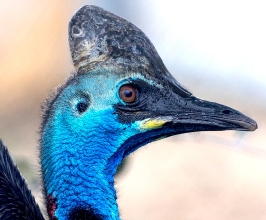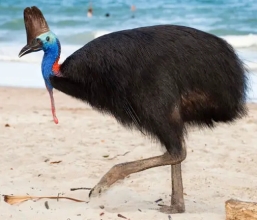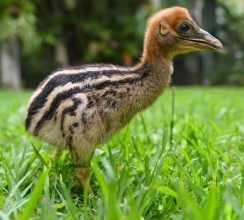  The cassowary is a large, flightless bird most closely related to the emu. Although the emu is taller, the cassowary is the heaviest bird in Australia and the second heaviest in the world after the ostrich. Cassowaries range across Northern Australia, New Guinea, and the surrounding islands. They live in tropical forests and wetlands.
The cassowary is a large, flightless bird most closely related to the emu. Although the emu is taller, the cassowary is the heaviest bird in Australia and the second heaviest in the world after the ostrich. Cassowaries range across Northern Australia, New Guinea, and the surrounding islands. They live in tropical forests and wetlands.Adult cassowaries are jet black, with colourful skin colors on their face and neck. They can stand up to 2 m tall and weigh as much as 60 kg.  The cassowary's black feathers from a distance look like hair. These feathers aren't designed for flight, but for protection, keeping the bird dry and safe from the sharp thorns found on many plants. Cassowaries have a casque, also called a helmet, on top of their head The cassowary's black feathers from a distance look like hair. These feathers aren't designed for flight, but for protection, keeping the bird dry and safe from the sharp thorns found on many plants. Cassowaries have a casque, also called a helmet, on top of their head The casque is made of a sponge-like material and covered with a thick layer of keratin, the same thing our fingernails are made of. No one knows for certain the purpose of the casque. It could reveal a bird’s age or dominance, or be used as a sort of shock absorber that protects the bird's head as it pushes through the rainforest underbrush. The casque could also work much like a hornbill's casque does in helping the bird make sounds. Cassowaries hiss and whistle to communicate, and clap their bills or rumble when making a threat. The rumble is so low and powerful that wildlife specialists working with the birds report they can feel it in their bones.   Two of the three cassowary species have wattles, or bare, fleshy pouches of skin that hang from the neck. These wattles are brightly colored blue, red, gold, purple, or white, depending on the species or subspecies. Two of the three cassowary species have wattles, or bare, fleshy pouches of skin that hang from the neck. These wattles are brightly colored blue, red, gold, purple, or white, depending on the species or subspecies. Their purpose may be to indicate the bird’s mood, or relay other social cues. Cassowaries are very difficult to observe and study, as they are quick to retreat into the rainforest, so little is known about their behaviour. They seem to be most active at dawn and dusk (crepuscular behavior), or when they search for food.  The cassowary is considered the most dangerous bird in the world. Each three-toed foot has a dagger-like claw on the inner toe that is up to 10 centimetres long. The cassowary can slice open a predator with a single swift kick. The cassowary is considered the most dangerous bird in the world. Each three-toed foot has a dagger-like claw on the inner toe that is up to 10 centimetres long. The cassowary can slice open a predator with a single swift kick. If a cassowary feels threatened, it will leap up as much as 2 metres and strike out with its feet. As well, powerful, muscular legs help the cassowary run up to 50 kilometres per hour through the dense forest underbrush. Cassowaries are also strong swimmers. Cassowaries feed on the fruits of several hundred rainforest plants. Because their digestive tract is relatively short, their droppings contain fruit seeds that are only partially digested. One test showed that seeds from one rare Australian rainforest tree were much more likely to sprout after passing through a cassowary’s digestive tract than those that simply fell to the ground. In fact, many plants require passage through the cassowary's digestive system to be able to sprout. Cassowaries are solitary most of the year. If two males meet accidentally, they stretch, fluff up their feathers, and rumble at each other until one decides to leave. But if a male meets a female, she can usually make him run merely by stretching a little and staring quietly. Once the female lays three to five green eggs, she moves on, leaving the male to incubate the eggs and look after the hatchlings. Like the female emu, she may find and breed with another male and lay another clutch of eggs. The male sits on the nest to incubate the eggs for up to 60 days. Once the brown-and-tan striped chicks hatch, he leads them to his regular feeding grounds, protecting them and teaching them how to survive. Youngsters stay with their father for up to 16 months, when he chases them off to live on their own so he can get ready to breed again. By this time, they are almost adult size and can take care of themselves. 
 |